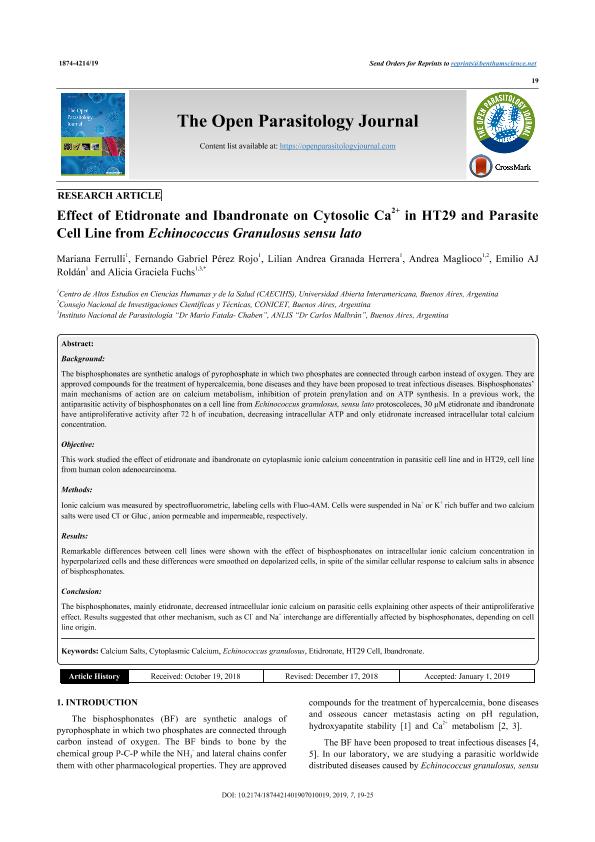Artículo
Effect of Etidronate and Ibandronate on Cytosolic Ca2+ in HT29 and Parasite Cell Line from Echinococcus Granulosus sensu lato
Ferrulli, Mariana; Pérez Rojo, Fernando Gabriel; Granada Herrera, Lilian Andrea; Maglioco, Andrea Florencia ; Roldán, Emilio A. J.; Fuchs, Alicia Graciela
; Roldán, Emilio A. J.; Fuchs, Alicia Graciela
 ; Roldán, Emilio A. J.; Fuchs, Alicia Graciela
; Roldán, Emilio A. J.; Fuchs, Alicia Graciela
Fecha de publicación:
02/2019
Editorial:
Bentham Science Publishers
Revista:
The Open Parasitology Journal
ISSN:
1874-4214
Idioma:
Inglés
Tipo de recurso:
Artículo publicado
Clasificación temática:
Resumen
Background: The bisphosphonates are synthetic analogs of pyrophosphate in which two phosphates are connected through carbon instead of oxygen. They are approved compounds for the treatment of hypercalcemia, bone diseases and they have been proposed to treat infectious diseases. Bisphosphonates’ main mechanisms of action are on calcium metabolism, inhibition of protein prenylation and on ATP synthesis. In a previous work, the antiparasitic activity of bisphosphonates on a cell line from Echinococcus granulosus, sensu lato protoscoleces, 30 µM etidronate and ibandronate have antiproliferative activity after 72 h of incubation, decreasing intracellular ATP and only etidronate increased intracellular total calcium concentration. Objective: This work studied the effect of etidronate and ibandronate on cytoplasmic ionic calcium concentration in parasitic cell line and in HT29, cell line from human colon adenocarcinoma. Methods: Ionic calcium was measured by spectrofluorometric, labeling cells with Fluo-4AM. Cells were suspended in Na+ or K+ rich buffer and two calcium salts were used Cl- or Gluc- , anion permeable and impermeable, respectively. Results: Remarkable differences between cell lines were shown with the effect of bisphosphonates on intracellular ionic calcium concentration in hyperpolarized cells and these differences were smoothed on depolarized cells, in spite of the similar cellular response to calcium salts in absence of bisphosphonates. Conclusion: The bisphosphonates, mainly etidronate, decreased intracellular ionic calcium on parasitic cells explaining other aspects of their antiproliferative effect. Results suggested that other mechanism, such as Cl- and Na+ interchange are differentially affected by bisphosphonates, depending on cell line origin
Archivos asociados
Licencia
Identificadores
Colecciones
Articulos(SEDE CENTRAL)
Articulos de SEDE CENTRAL
Articulos de SEDE CENTRAL
Citación
Ferrulli, Mariana; Pérez Rojo, Fernando Gabriel; Granada Herrera, Lilian Andrea; Maglioco, Andrea Florencia; Roldán, Emilio A. J.; et al.; Effect of Etidronate and Ibandronate on Cytosolic Ca2+ in HT29 and Parasite Cell Line from Echinococcus Granulosus sensu lato; Bentham Science Publishers; The Open Parasitology Journal; 7; 1; 2-2019; 19-25
Compartir
Altmétricas



